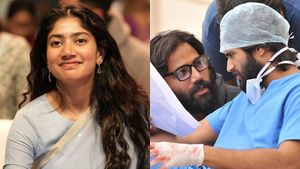NEW ORLEANS -- A shocking alliance has surfaced between the New Orleans Saints and the Catholic Church amid the fallout from the clergy sexual abuse scandal. Recent documents reveal just how deeply involved the NFL franchise was in managing the church’s public relations response during this fraught time.
According to hundreds of internal emails obtained by The Associated Press, the Saints’ front office, including team president Dennis Lauscha and senior vice president of communications Greg Bensel, played a pivotal role behind the scenes. This involvement was far more extensive than previously acknowledged by the organization, which claimed its participation was minimal when the scandal first broke.
The correspondence details how, as church leaders prepared to release a list of credibly accused priests, they turned to the Saints for crisis management assistance. Bensel and his team orchestrated strategies to mitigate public backlash, indicating the Saints were crafting responses and even influencing media narratives around the scandal.
Significantly, Saints executives were reportedly among the first to view the list of accused clergy. This was no minor role; Bensel's updates to Lauscha indicated how intertwined the church's messaging was with the football team's branding. “He is doing well,” Bensel wrote after Archbishop Gregory Aymond faced reporters. “That is our message, we will not stop here today.”
The influx of emails highlighted the church's crisis communication strategies. They painted the organization as deeply invested in shielding the church from the scandal’s fallout, which has since broadened to include over 600 lawsuits aimed at the Archdiocese of New Orleans. The litigation has substantial financial stakes, even forcing the church to file for bankruptcy due to the growing wave of claims.
This strategic alliance was brought to light through legal proceedings, with the Saints coming under increased scrutiny. “This is disgusting,” remarked state Rep. Mandie Landry, D-New Orleans. “It doesn’t make any sense to me why the Saints would go to these lengths to protect grown men who raped children.” Landry’s sentiments echoed sentiments shared among many community members and victims of abuse.
Immediately prior to the church’s release of the names, Bensel corresponded with local prosecutors, apparently preparing to alleviate the list's potential damage. “We took certain people off the list,” he noted, though questions remain about who was omitted and why this decision was made. These revelations have drawn widespread condemnation from survivor advocates, with Kevin Bourgeois, a victim of clergy abuse stating, “We felt betrayed by the organization.” They expressed anger at the Saints’ involvement, fearing clandestine practices remained hidden.
The Saints, initially defending their position, released statements asserting their disapproval of the actions leading to clergy abuse. “No member of the Saints organization condones or wants to cover up the abuse... That abuse occurred is a terrible fact,” the team claimed. Despite their vocal disapproval of these actions, the public's trust is waning.
The outcome of the Saints' alliance with the church has yet to be fully realized. The franchise has faced scrutiny not only from the community but also from the NFL, which has remarked upon the potential violation of league policies concerning detrimental conduct. NFL Commissioner Roger Goodell is due to address the media amid Super Bowl celebrations, which may bring forth questions about the findings.
Emails also pointed to the relationship between the Saints’ leadership and local media outlets. Bensel, proven to be instrumental, crafted numerous talking points for Aymond and actively sought to align the church’s public narrative with favorable coverage. His efforts to cultivate positive relationships with influential journalists indicated deep-rooted connections meant to circumvent negative stories or criticisms, with local editorials praising Aymond's handling of the crisis forthcoming.
Evidence emerged showcasing how everything from local judges to media leaders aligned with church figures during this crisis. U.S. District Court Judge Jay Zainey praised Bensel’s efforts, encouraging collaboration with the church from both media and judicial perspectives. During this time, Zainey struck down legislation allowing abuse survivors greater ability to file claims, which many saw as protective measures for the church.
The release of the list of accused priests became both a watershed moment and source of contention within the Jesuit community. It aimed to show accountability during desperate times for the church, arriving amid calls for civil justice from more than 600 people claiming clergy abuse. Nevertheless, the list itself was criticized post-release for omitting significant names implicated through civil lawsuits or criminal charges.
Since its release, investigations remain underway and heightened scrutiny from law enforcement is evident, with both federal and state agencies stepping forward. The email revelations have escalated concerns and pointed to the need for continued investigations as new legal claims mount.
Now, the fallout from the Saints’ involvement continues to transform the conversation around the abuse crisis, mixing complex narratives of sports and faith as they both grapple with responses to the heinous misdeeds of the past. The consequences of their actions will resonate within the New Orleans community as they seek healing and accountability for the long-lasting impacts of clergy abuse.



